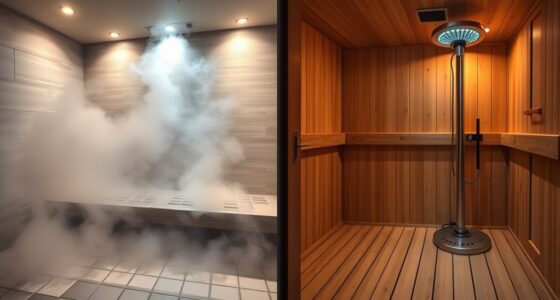To control humidity in your sauna effectively, understand the ideal levels for your sauna type—10-20% for traditional, 20-30% for infrared, and near 100% for steam. Use tools like hygrometers and choose suitable devices such as humidifiers or moisture absorbers. Adjust humidity by adding water, using spray bottles, or ventilating. Regular maintenance guarantees reliable performance. Keep exploring to discover detailed tips that help you optimize every session for maximum comfort and health.
Key Takeaways
- Understand optimal humidity ranges for different sauna types: 10-20% for traditional, 20-30% for infrared, and near 100% for steam saunas.
- Use appropriate monitoring tools like hygrometers and moisture meters for accurate, real-time humidity measurement.
- Employ suitable humidification devices (ultrasonic, steam, evaporative) and control methods to increase or decrease humidity effectively.
- Regularly calibrate and maintain humidifiers and sensors to ensure reliable performance and safe operation.
- Customize humidity levels based on personal preferences and environmental factors to optimize comfort, health benefits, and safety.
Understanding the Importance of Humidity in Saunas
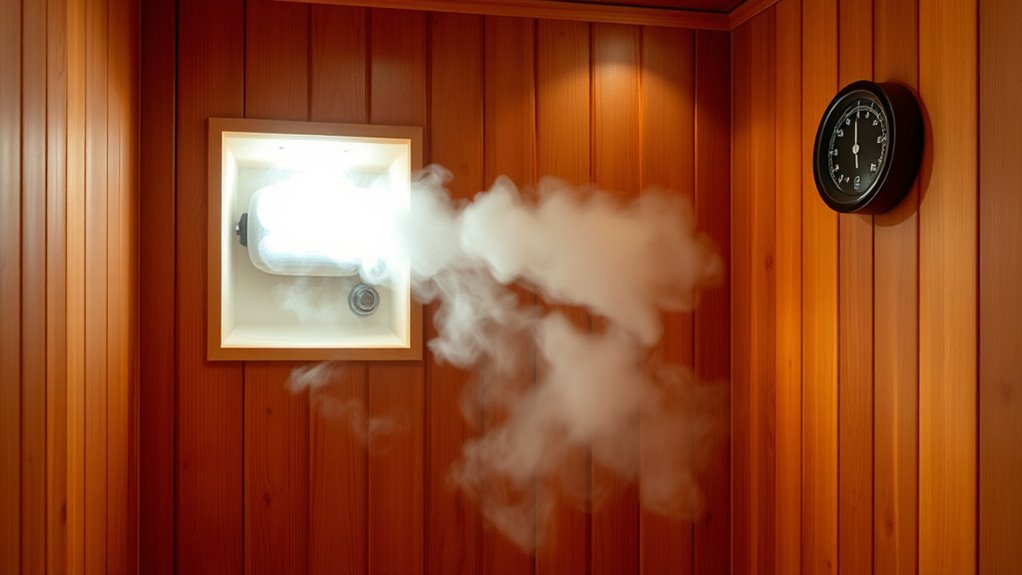
Humidity plays a essential role in shaping your sauna experience, as it directly affects how your body perceives heat and comfort. Many humidity myths suggest that lower humidity always means a better sauna, but the truth is more nuanced. Proper sauna ventilation is key to maintaining balanced humidity levels, preventing the air from becoming too dry or too damp. When ventilation works effectively, it helps control moisture, ensuring you don’t feel overwhelmed by excessive humidity or discomfort caused by overly dry air. Understanding this balance is fundamental because it influences how your body responds to heat, sweat production, and overall relaxation. Additionally, high-quality projectors can enhance your sauna ambiance by providing calming visual displays, making your experience more immersive. By debunking humidity myths and optimizing ventilation, you can tailor your sauna environment to maximize comfort and health benefits.
How Humidity Levels Impact Sauna Comfort and Health

Maintaining the right humidity levels in your sauna can substantially influence how comfortable and healthy your experience feels. When humidity fluctuates too much, it can cause discomfort, making you feel overly sweaty or dehydrated. Proper humidity promotes moisture evaporation from your skin, helping you cool down and prevent overheating. Low humidity can leave your skin feeling dry and itchy, while high humidity may lead to breathing issues or dizziness. Balancing humidity supports better respiratory health and reduces stress on your cardiovascular system. By controlling humidity, you optimize both comfort and health benefits, ensuring your sauna sessions are safe and enjoyable. Remember, consistent humidity levels help your body adapt smoothly, making each visit more effective and relaxing. Regular humidity control can also prevent mold growth and maintain a cleaner sauna environment.
Tools and Devices for Monitoring Sauna Humidity

To keep your sauna comfortable, you’ll need reliable tools to monitor humidity levels accurately. Hygrometers and moisture meters provide quick readings, while humidity control devices help you adjust the environment easily. Smart monitoring systems offer real-time data and automation for ideal moisture control. Incorporating HEPA filtration in your air quality system can further improve air purity and reduce allergens in your sauna environment.
Hygrometers and Moisture Meters
Hygrometers and moisture meters are essential tools for accurately monitoring the humidity levels inside your sauna. Digital hygrometers provide quick, precise readings, helping you maintain ideal moisture. Many models feature built-in moisture sensors that detect humidity changes in real-time, ensuring you’re always aware of your sauna’s conditions. With these devices, you can easily track fluctuations and make adjustments to keep the environment comfortable and safe. Digital hygrometers are user-friendly and often include digital displays for easy reading. Moisture meters, on the other hand, measure the moisture content in surfaces or air, giving you detailed insights. Investing in reliable hygrometers and moisture sensors allows you to fine-tune humidity levels, enhancing your sauna experience and prolonging equipment lifespan. Proper Mazda Tuning techniques can also optimize your sauna’s humidity control for better performance and safety.
Humidity Control Devices
Effective humidity control in your sauna relies on a variety of tools and devices designed to monitor and regulate moisture levels. Humidity control devices include different humidifier types, such as ultrasonic, steam, and evaporative models, each suited for specific sauna environments. These devices help maintain ideal moisture by adding humidity when needed. Additionally, moisture absorption tools like desiccants or moisture-absorbing panels can reduce excess humidity, preventing discomfort and damage. Properly using these devices ensures consistent humidity levels, improving your sauna experience while protecting its structure. Regularly checking and adjusting humidity control devices keeps your sauna comfortable and safe. Remember, choosing the right tools depends on your sauna’s size, insulation, and desired humidity range. To optimize digital literacy and critical thinking skills, consider integrating smart sensors that provide real-time humidity data for more precise control.
Smart Monitoring Systems
Smart monitoring systems have revolutionized how you oversee sauna humidity, providing real-time data and precise control. By strategically placing sensors in key areas, you guarantee accurate readings of humidity levels. Proper sensor placement is essential for reliable monitoring, helping you avoid dead spots or false readings. These systems leverage wireless connectivity, allowing you to access data remotely through apps or control panels. With wireless links, you can adjust humidity settings instantly, guaranteeing optimal comfort and safety. Advanced smart monitors often feature alerts for humidity fluctuations, so you can make quick adjustments or troubleshoot issues. Overall, these tools streamline humidity management, making your sauna experience more consistent, efficient, and enjoyable. Additionally, understanding AI security vulnerabilities can help in designing more secure and reliable monitoring systems.
Ideal Humidity Range for Different Types of Saunas
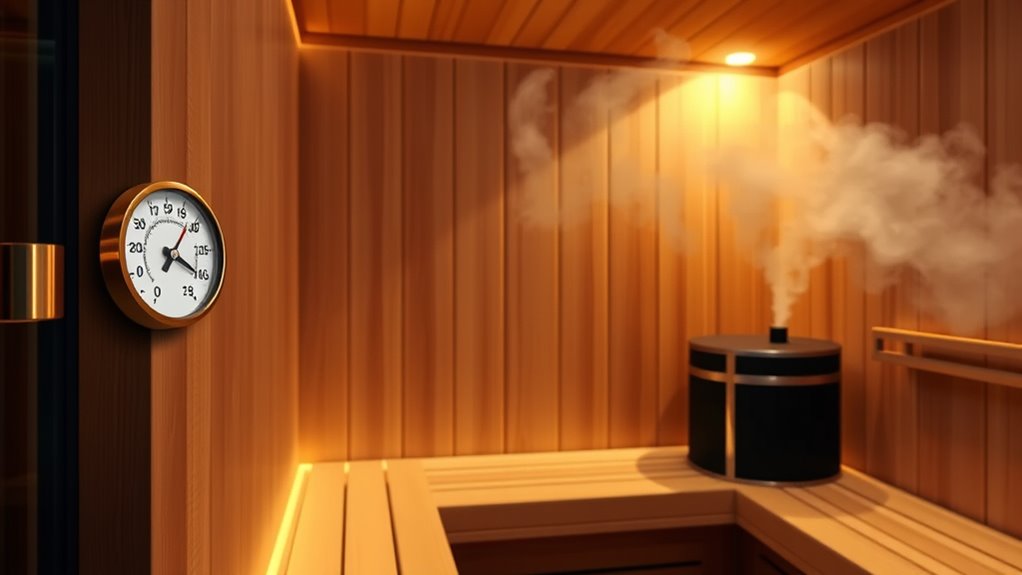
Understanding the ideal humidity range depends on the type of sauna you’re using. Traditional saunas typically operate between 10-20%, while infrared saunas often stay lower at around 10%. Steam saunas, on the other hand, require humidity levels near 100% for maximum comfort and effectiveness. Additionally, proper humidity control enhances user safety and overall sauna experience.
Traditional Sauna Humidity
Traditional saunas typically maintain a humidity level between 10% and 20%, creating a dry heat environment that promotes sweating and relaxation. You’ll notice that humidity fluctuations are minimal, thanks to effective sauna ventilation which helps keep the environment consistent. Proper ventilation prevents excess moisture buildup, maintaining the ideal dry conditions that define traditional saunas. If humidity rises too high, it can make the air feel heavier, reducing comfort and potentially causing damage over time. Conversely, if it dips too low, sweating becomes less effective. To keep the humidity steady within this range, verify your sauna’s ventilation system is well-maintained and functioning properly. This balance fosters a comfortable, safe environment, maximizing the health benefits of your traditional sauna experience. Additionally, understanding city dynamics can help optimize your sauna setup for better comfort and safety.
Infrared Sauna Levels
Infrared saunas typically operate best within a humidity range of 20% to 30%, which helps maximize comfort and safety. Maintaining proper infrared sauna levels guarantees you enjoy the benefits without discomfort. To achieve this, humidity sensor placement is vital; placing sensors at face level or near the heater provides accurate readings.
Consider this overview:
| Humidity Level | Effect on Comfort | Ideal Use Case |
|---|---|---|
| 20-25% | Mild, comfortable | Relaxation sessions |
| 25-30% | Slightly moist | Enhanced sweating benefits |
| 30-35% | Noticeably humid | Specific therapeutic goals |
| 35-40% | High moisture | Less common, caution advised |
| 40%+ | Very humid | Not recommended for infrared |
This table helps visualize the ideal infrared sauna levels, guaranteeing the humidity sensor placement supports maximum control. Ensuring the humidity remains within this optimal range can also prevent discomfort or health issues, promoting a safer sauna experience.
Steam Sauna Standards
While infrared saunas operate comfortably within a specific humidity range, steam saunas require different standards to guarantee safety and effectiveness. In steam saunas, maintaining a humidity level between 60% and 100% is essential, but exceeding this range can cause discomfort or safety hazards. Using humidity sensors helps you monitor moisture levels precisely, ensuring ideal conditions. Proper moisture control prevents over-humidification, which can damage the sauna or create mold risks. For safety, keep humidity below 80% during sessions, adjusting the steam generator accordingly. Consistent monitoring with reliable humidity sensors allows you to maintain the perfect humidity range for your steam sauna, providing a safe, effective, and comfortable experience. Additionally, understanding humidity control techniques can optimize the sauna environment and extend its lifespan. Following these standards ensures your sauna performs at its best while safeguarding your health.
Techniques for Increasing Humidity in Your Sauna
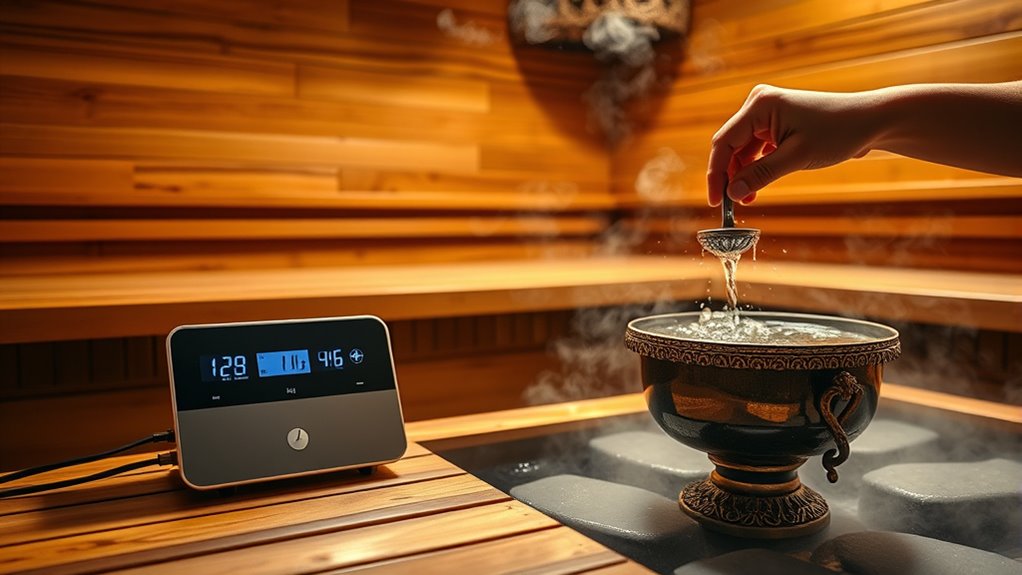
To increase humidity in your sauna effectively, you can start by adding water to the sauna stones during your session. Proper humidifier placement is key—position it where moisture absorption is maximized without causing water damage. Here are four techniques to boost humidity:
- Place a water basin near the heater for quick evaporation.
- Use a spray bottle to mist water directly onto the stones.
- Install a dedicated sauna humidifier in a strategic spot.
- Make certain good airflow to distribute moisture evenly.
Methods to Reduce Excess Moisture and Dryness
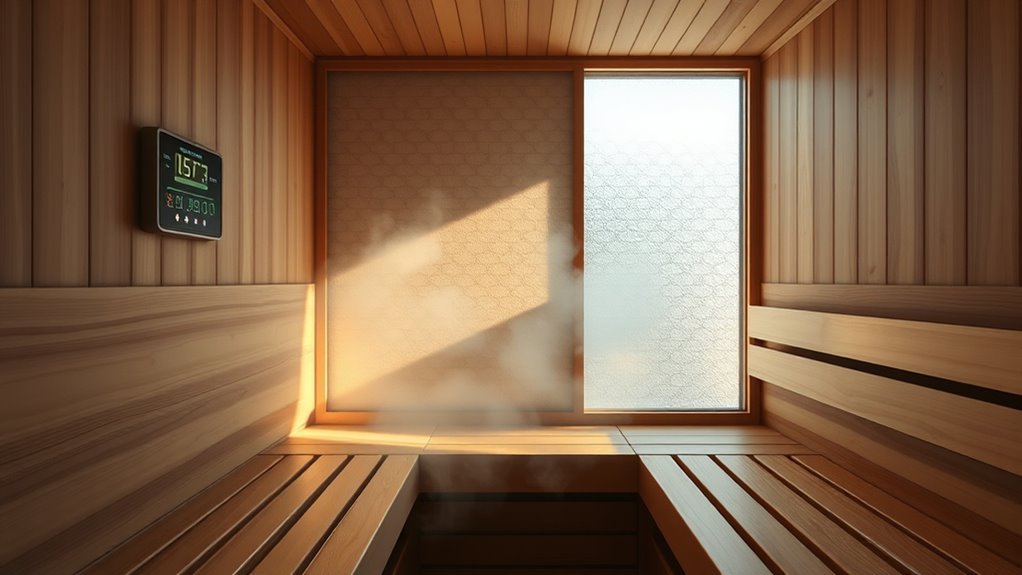
When excess moisture makes your sauna uncomfortable, it’s essential to take steps to dry the environment quickly. Start by adjusting humidifier placement to prevent adding more moisture where it’s not needed, such as away from vents or open windows. Use moisture absorption materials like desiccant packs or absorbent towels to draw out excess humidity. Ventilation also plays a key role; open vents or doors briefly to promote airflow and reduce humidity levels. Consider using a dehumidifier if your sauna setup permits, especially in enclosed spaces. Regularly monitor the humidity to avoid over-drying, which can be just as uncomfortable as excess moisture. These methods help maintain a balanced environment, ensuring your sauna remains comfortable and safe.
Troubleshooting Common Humidity Control Issues
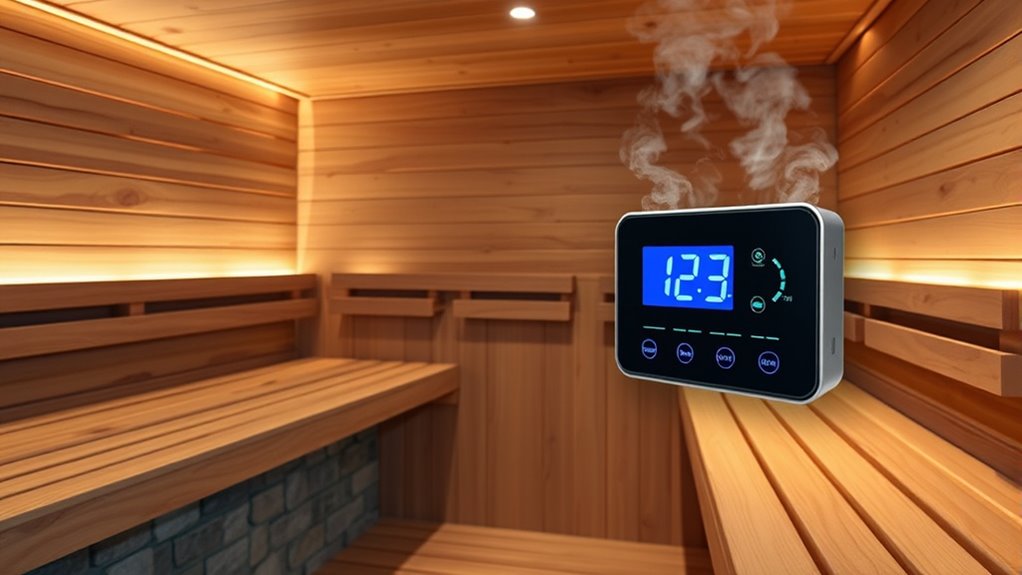
Even with proper techniques, humidity control in a sauna can still encounter common issues. One frequent problem involves inaccurate readings from humidity sensors, leading to improper moisture balancing. To troubleshoot effectively, consider these steps:
- Check that sensors are clean and correctly positioned for accurate readings.
- Calibrate sensors regularly to ensure dependability.
- Inspect ventilation and airflow, as poor circulation affects humidity levels.
- Test moisture sources, like water bowls or steam generators, to confirm they’re functioning properly.
If humidity remains inconsistent, replacing faulty sensors or adjusting moisture inputs may be necessary. Remember, consistent sensor maintenance and understanding how moisture moves in your sauna are key to resolving these issues efficiently. Proper troubleshooting keeps your humidity levels stable and your sauna experience ideal.
Integrating Humidity Control With Sauna Heating Systems
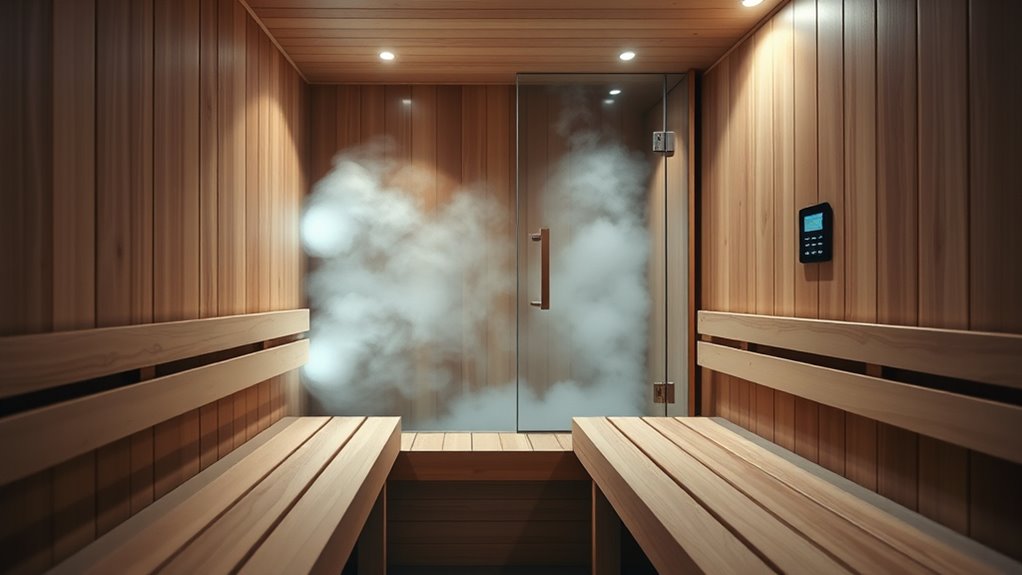
Integrating humidity control with sauna heating systems is essential for maintaining a comfortable and consistent environment. By using humidity sensors, you can precisely monitor moisture levels and adjust heating elements accordingly. This synergy ensures ideal moisture control without overshooting, which could cause discomfort or damage.
| Heating System | Humidity Control Method |
|---|---|
| Electric heater | Sensor-linked moisture regulation |
| Wood stove | Manual or automated humidifiers |
| Infrared panels | Integrated humidity sensors |
| Steam generator | Real-time moisture monitoring |
| Combined system | Automated adjustments based on sensor data |
This setup helps you maintain the desired humidity, improves comfort, and extends your sauna’s lifespan. Proper integration ensures seamless coordination between heating and humidity regulation, elevating your sauna experience.
Maintenance Tips for Optimal Humidity Regulation
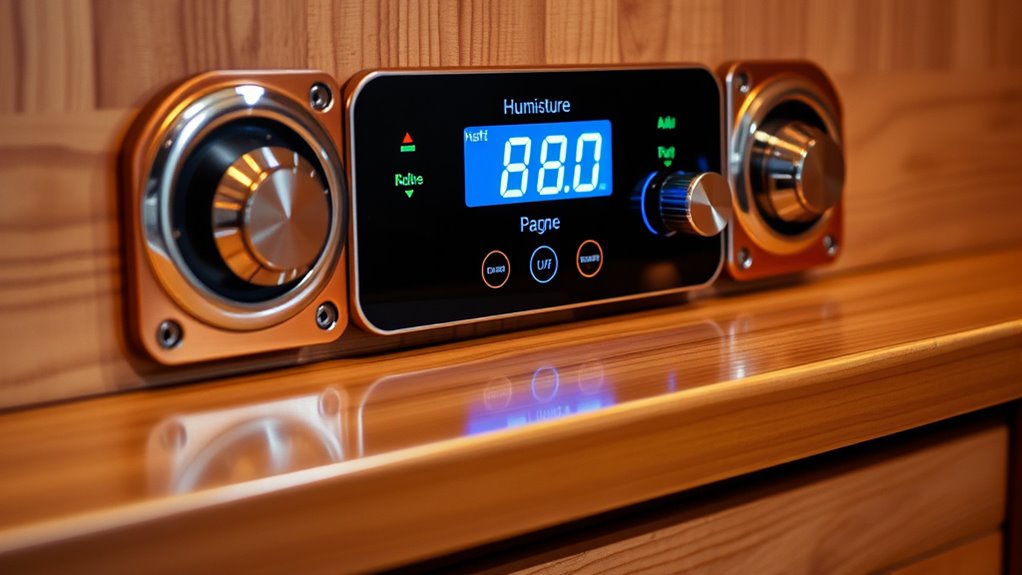
To keep your sauna’s humidity levels consistent, you need to regularly calibrate your humidifiers. It’s also important to inspect and replace any worn-out components to prevent malfunctions. Staying on top of these maintenance tasks guarantees your sauna stays comfortable and efficient.
Regularly Calibrate Humidifiers
Regularly calibrating your humidifiers is essential to maintain the correct humidity levels in your sauna. Proper calibration ensures your device’s sensor accuracy and consistent performance. To do this effectively, follow these steps:
- Use calibration techniques recommended by the manufacturer.
- Compare sensor readings with a reliable hygrometer.
- Adjust the humidifier settings based on discrepancies.
- Repeat calibration periodically for ongoing accuracy.
Inspect and Replace Components
Since worn or damaged components can impair your sauna’s humidity control, it’s important to regularly inspect them. Check ventilation strategies to guarantee airflow is unobstructed, preventing excess moisture buildup that can lead to mold growth. Replace any faulty vents, seals, or humidity sensors promptly to maintain accurate regulation. Inspect the heater and humidifier connections for corrosion or leaks, as these issues hinder proper function. Properly functioning components help you achieve desired humidity levels and prevent mold, which thrives in damp environments. By staying proactive with inspections and replacements, you’ll keep your sauna’s humidity consistent and safe. Regular maintenance not only enhances performance but also extends the lifespan of your sauna’s essential parts, ensuring ideal humidity regulation and mold prevention.
Customizing Humidity Settings for Personal Preferences
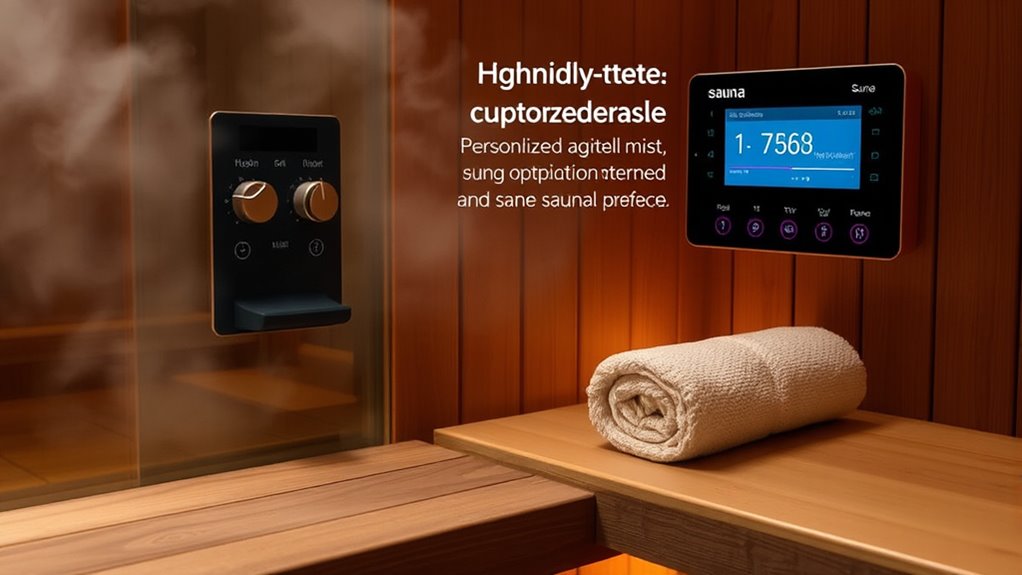
Adjusting the humidity levels in your sauna allows you to tailor the experience to your personal comfort. By customizing humidity settings, you create a more enjoyable and effective session. To achieve personalized humidity settings for perfect custom sauna comfort, consider these steps:
- Determine your preferred humidity level, ranging from dry to very humid.
- Use a hygrometer to monitor current humidity.
- Adjust the water infusion rate or steam generator accordingly.
- Experiment with small changes and record what feels best.
This approach ensures you find the ideal balance, making your sauna sessions more satisfying. Personalizing humidity settings lets you enjoy the benefits of a tailored environment, whether you prefer a gentle, humid atmosphere or a drier heat.
Frequently Asked Questions
How Does Humidity Affect Sauna Energy Efficiency?
Humidity affects sauna energy efficiency by influencing how hard the heater works. When humidity sensors detect high moisture levels, you can adjust the ventilation or humidity controls to optimize energy consumption. Maintaining proper humidity prevents the heater from overworking, saving energy and reducing costs. By monitoring humidity and adjusting settings accordingly, you guarantee your sauna operates efficiently while providing a comfortable, consistent experience.
Can Humidity Control Improve Sauna Odor Management?
Yes, humidity control can notably improve sauna odor management by enhancing air quality and aiding odor elimination. When you adjust humidity levels, you regulate moisture and airflow, preventing musty smells and reducing bacteria buildup. This creates a fresher environment, making your sauna more inviting. By maintaining ideal humidity, you guarantee better air circulation, which directly contributes to a cleaner, more pleasant sauna experience free from lingering odors.
Are There Safety Risks With Automatic Humidity Systems?
Automatic humidity systems can pose safety risks if you don’t follow proper safety protocols. Humidity sensors help regulate moisture levels, but if they’re faulty or improperly calibrated, they might cause excessive humidity, leading to mold or damage. Always guarantee your system is regularly maintained, and adhere to safety protocols like installing proper ventilation and monitoring settings. This way, you keep your sauna safe and enjoyable without risking health or equipment damage.
How Often Should Humidity Levels Be Recalibrated?
You should recalibrate your humidity sensors every 6 to 12 months, much like tuning a musical instrument to stay in harmony. Regular recalibration keeps your sauna’s humidity levels accurate, ensuring a comfortable experience. Follow a consistent recalibration schedule to prevent drift and maintain precise control. By doing so, you’ll enjoy a safe, relaxing sauna session every time, knowing your humidity sensors are providing reliable readings.
What Are the Best Practices for Humidity Maintenance During Off-Seasons?
During off-seasons, you should make seasonal adjustments to your sauna’s humidity levels by regularly checking humidity sensors. Keep the sensors clean and calibrated to guarantee accurate readings. Reduce humidity gradually if temperatures drop, and use dehumidifiers if necessary. Consistent monitoring helps prevent mold and dryness, maintaining ideal comfort. By staying proactive with sensor maintenance and seasonal adjustments, you keep your sauna in top condition year-round.
Conclusion
Mastering humidity control in your sauna enhances your experience and promotes better health. Did you know that maintaining ideal humidity levels can reduce respiratory issues and improve relaxation? By understanding how to monitor and adjust humidity, you’re ensuring a safer, more enjoyable sauna session every time. Keep experimenting with your settings, troubleshoot issues promptly, and enjoy the perfect balance of warmth and moisture tailored just for you. Your ideal sauna experience is within reach!





